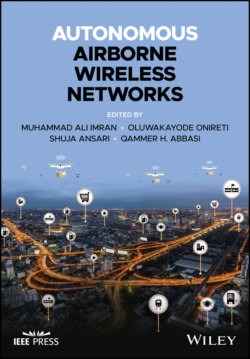Читать книгу Autonomous Airborne Wireless Networks - Группа авторов - Страница 4
List of Illustrations
Оглавление1 Chapter 2Figure 2.1 Aerial user equipment and aerial base station.Figure 2.2 Air‐to‐ground propagation in UAV‐assisted cellular network.Figure 2.3 Multipath air‐to‐ground propagation in urban setting.
2 Chapter 3Figure 3.1 The UWB measurement communication setup.Figure 3.2 The UWB antenna and the IRIS+ quadcopter used in the measurement ...Figure 3.3 The UWB antenna patch locations on the human body for the UWB mea...Figure 3.4 The sketch plan of the measurement campaign with the 10 distinct ...Figure 3.5 Different environments considered for the measurement campaign. (...Figure 3.6 Path loss factor determination from linear regression for a wirel...Figure 3.7 Averaged PDP at different distances.Figure 3.8 Normalized averaged path loss delay comparison.Figure 3.9 Statistical test (AIC) to determine the best distribution for fad...Figure 3.10 Empirical and predicted CDF for radio channel between forehead a...
3 Chapter 4Figure 4.1 Manhattan grid urban layout.Figure 4.2 UAV path loss in urban environment.Figure 4.3 MARL framework for multi‐drone networks.Figure 4.4 Available action sets. (a) Basic strategy action space. (b) All s...Figure 4.5 Basic strategy..Figure 4.6 ALL strategy.Figure 4.7 New strategy.Figure 4.8 User density areas. (a) Low density. (b) Medium density. (c) High...Figure 4.9 Single frequency: Number of users in outage. (a) Low density. (b)...Figure 4.10 Single frequency: Global system backhaul. (a) Low density. (b) M...Figure 4.11 Single frequency: Number of active drones. (a) Low density. (b) ...Figure 4.12 Three frequencies: Number of users in outage. (a) Low density. (...Figure 4.13 Three frequencies: Global system backhaul. (a) Low density. (b) ...Figure 4.14 Three frequencies: Number of active drones. (a) Low density. (b)...Figure 4.15 Six frequencies: Number of users in outage. (a) Low density. (b)...Figure 4.16 Six frequencies: Global system backhaul. (a) Low density. (b) Me...Figure 4.17 Six frequencies: Number of active drones. (a) Low density. (b) M...
4 Chapter 5Figure 5.1 Reference system model of self‐energized UAV‐assisted communicati...Figure 5.2 Block diagram of the decode‐and‐forward (DF) relaying for the sel...Figure 5.3 Time block diagram of the proposed system model.Figure 5.4 System layout for the proposed communication network.Figure 5.5 Achievable rate at the user versus for various values of cachin...Figure 5.6 Comparison of achievable rate at the user for different caching c...Figure 5.7 Transmission SNR versus achievable rate at the user for different...Figure 5.8 User requested rate versus optimal values of and : (a) when ...Figure 5.9 Optimized trajectory of the UAV for the given communication setup...
5 Chapter 6Figure 6.1 An illustration of mmWave/THz and UAVs integrated hybrid communic...Figure 6.2 Pictorial representation of UAV‐enabled wireless network.Figure 6.3 Stochastic geometry for the communication between an SCB and a UA...Figure 6.4 A snapshot of 3D placement of child‐UAVs and the association of S...Figure 6.5 Comparison of sum rate by varying the constraint (6.15) and (6.16...Figure 6.6 A comparison of unassociated SCBs and the sum rate with constrain...Figure 6.7 Performance of sum rate by varying the constraint (6.16) and havi...Figure 6.8 Sum rate's performance when the number of child‐UAVs and are va...
6 Chapter 7Figure 7.1 The UAV‐enabled cooperative jamming in cognitive radio system.Figure 7.2 Average secrecy rate versus flight time period.Figure 7.3 Trajectories of UAV with different methods.Figure 7.4 Distance between UAV and Eve.Figure 7.5 Convergence behavior. (a) Convergence behavior at dBm. (b) Aver...
7 Chapter 8Figure 8.1 Localization using IRS model with two IRSs and one SC.Figure 8.2 Localization of a UAV using multiple IRSs.
8 Chapter 9Figure 9.1 Flow chart explaining different architectures of UAV systems.Figure 9.2 UAV system's different topologies.Figure 9.3 UAV system's benefits in different applications.
9 Chapter 10Figure 10.1 Cellular Network‐assisted low‐altitude aerial base station (ABS)...Figure 10.2 Ray tracing simulation in urban environment.Figure 10.3 Variation of number of ABSs required with its altitude.Figure 10.4 Variation of number of ABSs required with its transmitting power...Figure 10.5 Variation of number of ABSs required with geographical area to b...Figure 10.6 TBS path loss and transmission power.Figure 10.7 Master UAV transmission power and line of sight.Figure 10.8 System for channel measurement.Figure 10.9 Received power by ground users from SUAVs cluster.Figure 10.10 64‐QAM throughput coverage area.
10 Chapter 11Figure 11.1 Qualitative comparison of the most diffused wireless communicati...Figure 11.2 Plausible network architectures, highlighting the use of MEC in
11 Chapter 12Figure 12.1 Complete system on UAV.Figure 12.2 Worst overall classification accuracy simulation result. (a) Ori...Figure 12.3 Worst false negative simulation result. (a) Original image. (b) ...Figure 12.4 Field experiment results for automated point labeling. (a) Origi...Figure 12.5 Winch and Raspberry Pi.Figure 12.6 Sensor payload.Figure 12.7 Spline results. (a) RMSE. (b) Maximum difference.Figure 12.8 IDW results. (a) RMSE. (b) Maximum difference.
12 Chapter 13Figure 13.1 Tier‐1 of satellite networks: It includes the connection of a sa...Figure 13.2 Tier‐2 of satellite networks: It includes the inter‐satellite li...Figure 13.3 Tier‐3 of satellite networks: It includes the communication of t...
